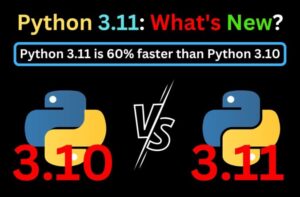Exploring the Performance Battle: Python vs. C++
Introduction:
In my exploration of the dynamic realm of programming languages, I recently stumbled upon a compelling discussion revolving around the perennial issue of performance. A YouTube video titled “Is Python going to be faster than C?” captivated my interest, as the presenter meticulously examined the showdown between Python and C++. Through a series of tests and insightful analyses, the video dissected the strengths and weaknesses inherent in both languages. Let’s delve into the key takeaways from this intriguing comparison.
Python 3.11 Performance Boost:
The video kicks off by spotlighting the remarkable performance strides made by Python 3.11 in comparison to its predecessor, Python 3.10. Using experimental arrays and the NumPy benchmark as testing grounds, Python 3.11 flaunted an astonishing improvement of over 54%. What’s noteworthy is that this enhancement wasn’t confined to experimental arrays but extended its influence to critical NumPy-style arrays as well. The presenter underlines the significance of these advancements, particularly when juxtaposed against older Python versions and certain stable releases.

Code Comparison – Python vs. C++:
To bolster the argument that Python generally lags behind C++ in terms of speed, the presenter conducts tests on both languages, employing a common set of functions, including the bayes_default_tti functions and a custom grid example function. The results are unequivocal – Python takes approximately 5 times longer to execute a specific function compared to C++. However, the presenter judiciously advises viewers to validate the correctness of the Python code before drawing conclusions solely based on execution times.
Understanding Latency and CPU Usage:
The video delves deeper into the intricacies of latency and the variance in CPU usage between Python and C++. While Python’s interpreted nature contributes to its comparatively slower execution, the presenter underscores the importance of factoring in these elements during performance evaluations. The audience is walked through the process of running the time function to vividly illustrate the disparities in results.
Python 3.11 vs. C++ Test Execution:
In a meticulous breakdown of the test execution, the presenter guides us through the steps of running Python 3.11 and C++ in execute mode and time IT model, respectively. The minimum execution time is extracted from multiple Python test runs, and specific C++ functions are tested with reported time values. The percentage difference is calculated, providing a quantitative metric for the performance comparison.

Conclusion:
In wrapping up, the video casts a spotlight on the perennial Python vs. C++ debate, underscoring Python’s strengths in certain scenarios, particularly with the commendable performance boost in Python 3.11. While conceding that Python may still trail C++ in raw execution speed, the presenter suggests that users should contemplate transitioning to Python if its performance aligns with their specific requirements. As technology marches forward, the landscape of programming languages and their performance capabilities is destined to evolve, making this an exhilarating space to monitor closely.
Is Python is going to be faster than C++?
Title: Exploring the Performance Battle: Python vs. C++
Introduction:
In my exploration of the dynamic realm of programming languages, I recently stumbled upon a compelling discussion revolving around the perennial issue of performance. A YouTube video titled “Is Python going to be faster than C?” captivated my interest, as the presenter meticulously examined the showdown between Python and C++. Through a series of tests and insightful analyses, the video dissected the strengths and weaknesses inherent in both languages. Let’s delve into the key takeaways from this intriguing comparison.
Python 3.11 Performance Boost:
The video kicks off by spotlighting the remarkable performance strides made by Python 3.11 in comparison to its predecessor, Python 3.10. Using experimental arrays and the NumPy benchmark as testing grounds, Python 3.11 flaunted an astonishing improvement of over 54%. What’s noteworthy is that this enhancement wasn’t confined to experimental arrays but extended its influence to critical NumPy-style arrays as well. The presenter underlines the significance of these advancements, particularly when juxtaposed against older Python versions and certain stable releases.

Code Comparison – Python vs. C++:
To bolster the argument that Python generally lags behind C++ in terms of speed, the presenter conducts tests on both languages, employing a common set of functions, including the bayes_default_tti functions and a custom grid example function. The results are unequivocal – Python takes approximately 5 times longer to execute a specific function compared to C++. However, the presenter judiciously advises viewers to validate the correctness of the Python code before drawing conclusions solely based on execution times.
Understanding Latency and CPU Usage:
The video delves deeper into the intricacies of latency and the variance in CPU usage between Python and C++. While Python’s interpreted nature contributes to its comparatively slower execution, the presenter underscores the importance of factoring in these elements during performance evaluations. The audience is walked through the process of running the time function to vividly illustrate the disparities in results.
Python 3.11 vs. C++ Test Execution:
In a meticulous breakdown of the test execution, the presenter guides us through the steps of running Python 3.11 and C++ in execute mode and time IT model, respectively. The minimum execution time is extracted from multiple Python test runs, and specific C++ functions are tested with reported time values. The percentage difference is calculated, providing a quantitative metric for the performance comparison.
Conclusion:
In wrapping up, the video casts a spotlight on the perennial Python vs. C++ debate, underscoring Python’s strengths in certain scenarios, particularly with the commendable performance boost in Python 3.11. While conceding that Python may still trail C++ in raw execution speed, the presenter suggests that users should contemplate transitioning to Python if its performance aligns with their specific requirements. As technology marches forward, the landscape of programming languages and their performance capabilities is destined to evolve, making this an exhilarating space to monitor closely.



Leave A Comment